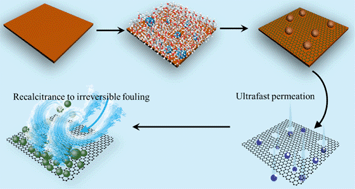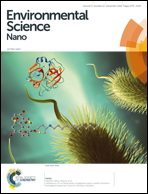Direct growth of ultra-permeable molecularly thin porous graphene membranes for water treatment†
Abstract
Membranes have shown excellent performance in water treatment but still suffer from two important technical limitations—the compromise between permeability and selectivity, and membrane fouling. Empirical evidence suggests that ultrathin membranes may achieve the ultimate permeation and the preclusion of irreversible fouling. Considering the atomic thickness of graphene, we present for the first time a direct growth method of molecularly thin porous graphene membranes, through a synchronous thermal conversion and chemical etching process. Such graphene membranes allow for ultrafast water permeation, affording a permeance of up to 182 000 L m−2 h−1 bar−1, which is 2 orders of magnitude higher than that of conventional membranes, with a similar pore size of approximately 50 nm, and comparable to that of the reported state-of-the-art membranes. Additionally, much higher recalcitrance to irreversible fouling (in terms of higher flux recovery after a simple hydrodynamic flush) is observed, compared with polyvinylidene fluoride ultrafiltration membranes, during the filtration of engineered polystyrene nanoparticles and humic acid molecules. Both the high permeability and resistance to irreversible fouling of the graphene membranes can be attributed to their molecularly thin structure, perpendicular pore channels and appropriate surface chemistry.



 Please wait while we load your content...
Please wait while we load your content...